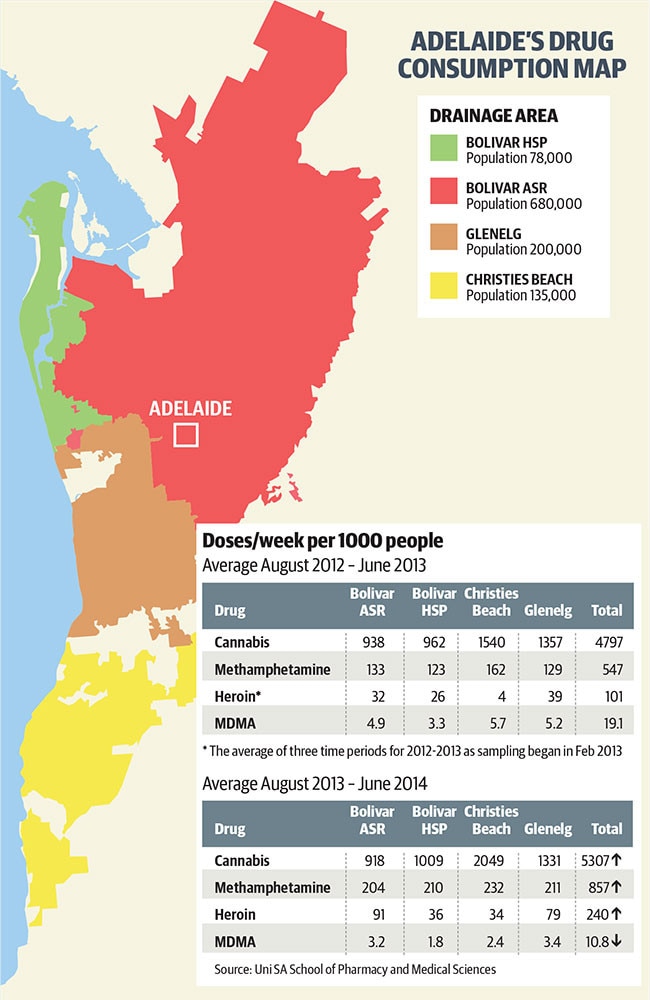Sewer tests reveal huge increase in use of methamphetamines in Adelaide
THE use of methamphetamines has jumped by more than 55 per cent in just 12 months in Adelaide. And officials have discovered this alarming trend by testing wastewater.
THE use of methamphetamines — which include the deadly stimulant ice — has jumped more than 55 per cent in just a 12-month period in Adelaide, alarming tests have revealed.
The drug testing of wastewater at Adelaide’s four sewage collection stations also reveals that while heroin and cannabis use has increased, it has not been as steep in the same period.
Professor Jason White, head of the School of Pharmacy and Medical Sciences at UniSA, said the testing figures were a valuable “very near real time’’ record of the increased level of methamphetamine use in Adelaide.
“It is very much something that is spreading at a rate that does cause alarm, that would be fair to say,’’ he said.
“We did not have any prior hard evidence that methamphetamine use had increased, but there was a general impression from police in particular and health people there were relatively large amounts of methamphetamine around,’’ he said.
“What this does is provide us with the hard evidence and enables us to quantify the changes that are occurring.’’
Studies by both the Australian Crime Commission and the National Drug and Alcohol Resource Centre suggest the use of ice, which began emerging in Australia a decade ago, has increased dramatically in recent years, and that users of less potent amphetamine-based drugs such as “speed” are increasingly switching to it.
This year’s ACC report into illicit drugs indicated the number of Ice seizures was up more than 300 per cent in one year.
Ice get its name from its crystallised form, which can be smoked rather than injected, and which can cause violent rages and dramatic health problems in regular users, as well as death from overdoses.

Surveys of Adelaide club patrons have suggested that as many as one-in-five have used methamphetamines including Ice, which is cheap and seen as a party stimulant, allowing users to go without sleep for extended periods, sometimes days. It is extremely addictive.
The Adelaide sewage testing reveals that between August 2013 and June this year, 857 doses per week per 1000 people were consumed — compared with 547 doses in the corresponding period a year earlier — which equates to a 56.5 per cent increase. Each dose is measured as 30 milligrams of pure methamphetamine.
Professor White said the magnitude of the increase in methamphetamine use had been a surprise because it was thought some of the other monitoring methods may have picked up the rise.
“The magnitude is probably greater than we expected,’’ he said.
“Certainly over one 12-month period to another it is quite a substantial increase.’’
The testing has been conducted every two months since 2011 at Adelaide’s four sewage treatment stations — two at Bolivar, and at Glenelg and Christies Beach.
The two Bolivar plants collect and treat the effluent from over half of Adelaide — the northern, north-eastern and eastern suburbs and the central city.
Professor White said that “any increase in methamphetamine use is of concern’’ considering the drug was responsible for significant medical and social problems.
“It is a drug that causes a number of problems. It can cause health issues for people, they can be short-term ones, there is a risk of cardiac arrest for example, it causes psychiatric problems,’’ he said.

The most recent test results indicated the rise may be levelling out, but it was too early to be definitive.
Professor White said the figures for methamphetamine use at weekends showed an average 20 per cent increase over weekdays, indicating recreational use was higher at weekends.
“It is much less of a weekly pattern that you would get with ecstasy or cocaine, which is predominantly used on weekends,’’ he said.
And while methamphetamine use was constant, cannabis appeared to be seasonal, with an increase recorded every April. Opiate drug use, which includes many painkilling medicines, also increased slightly in winter, most likely because of illnesses.
The cannabis increase was attributed to being when cannabis grown outdoors matured and availability in the marketplace increased.
The figures show 5307 cannabis doses were recorded in the latest period, compared with 4797 in the previous period.
They reveal heroin use increased to 240 doses per week per 1000 people in the latest period, up from 101 in the corresponding previous period. A sharp rise was recorded at Glenelg in December last year, which accounted for most of the increase.
The drug testing figures are provided to both police and the Health Department to enable them to tailor treatment and intervention strategies.
Police Assistant Commissioner Paul Dickson said the wastewater testing figures supported police figures from several sources, including drug-driver testing, general detections and arrests.
The usage figures were also reflected in the number of illegal laboratories police had been discovering. They had increased from 58 in the 2011-12 financial year to 80 last financial year, but a change in reporting methodology also contributed slightly to that increased number.
“There has been an increase locally that has been reflected nationally which has seen the number increase from 353 in 2003-04 to 757 in 2012-13,’’ he said.
“We are fully aware of the increase and have implemented a number of strategies as a result,’’ he said.
